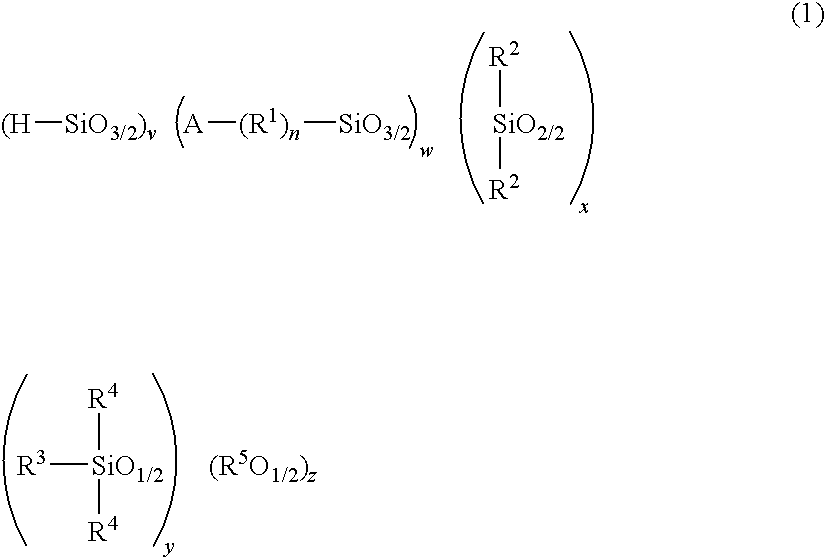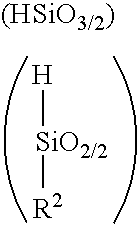Polysiloxane, method for producing the same, and method for producing cured product of the same
a technology of polysiloxane and cured product, applied in the direction of coatings, etc., to achieve the effect of good cured film, good heat resistance, and low viscosity
- Summary
- Abstract
- Description
- Claims
- Application Information
AI Technical Summary
Benefits of technology
Problems solved by technology
Method used
Image
Examples
example 1
[0144]A magnetic rotor, a dropping funnel, a reflux condenser and a thermometer were attached to a 1,000 ml four-necked flask, and the inside of the flask was purged with nitrogen gas. During the reaction, nitrogen gas was continuously flowed.
[0145]The flask was charged with 59.14 g (360 mmol) of triethoxysilane, 17.79 g (120 mmol) of trimethoxyvinylsilane, 6.92 g (57.6 mmol) of dimethoxydimethylsilane, 16.12 g (120 mmol) of 1,1,3,3-tetramethyldisiloxane, 88.38 g of 2-propanol, and 265.14 g of xylene.
[0146]After that, a mixture of 34.96 g of 1.28% hydrochloric acid and 44.19 g of 2-propanol was gradually added through the dropping funnel to the above mixture in a room-temperature state (19° C.) while stirring. During the dropping, a liquid temperature in the flask was maintained in a range from 19° C. to 22° C. After the dropping of the mixture of hydrochloric acid and 2-propanol was finished, the reaction liquid was left at a room temperature for 18 hours.
[0147]Subsequently, a vola...
example 2
[0162]Except that 44.35 g (270 mmol) of triethoxysilane, 13.34 g (90 mmol) of trimethoxyvinylsilane, 2.16 g (18 mmol) of dimethoxydimehylsilane, 12.09 g (90 mmol) of 1,1,3,3-tetramethyldisiloxane, 95.07 g of 2-propanol, 190.14 g of xylene, and 22.01 g of 1.28% hydrochloric acid were used, 31.10 g of a slightly pale yellow liquid (hereinafter referred to as “polysiloxane (P2)”) was obtained in the same manner as Example 1. This polysiloxane (P2) was measured for Mn, and the result was 1,100. In addition, viscosity at 25° C. was measured, and the result was 34 mPa·s (See Table 1).
[0163]Analytical results of 1H-NMR for the polysiloxane (P2) were as follows.
[0164]1H-NMR (C6D6, δ (ppm): −0.2-0.6 (br, Si—CH3), 0.9-1.5 (br, OCH(CH3)2, OCH2CH3), 3.5-4.1 (br, OCH2CH3), 4.1-5.5 (br, OCH(CH3)2, Si—H), 5.7-6.4 (br, CH═CH2).
[0165]A reaction rate of 1,1,3,3-tetramethyldisiloxane turned out to be 64% from 1H-NMR.
[0166]Additionally, an unreacted or generated alkoxysilyl group such as isopropoxysily...
example 3
[0169]Except that 49.28 g (300 mmol) of triethoxysilane, 12.60 g (85 mmol) of trimethoxyvinylsilane, 3.36 g (15 mmol) of trimethoxy (4-vinylphenyl)silane, 5.77 g (48 mmol) of dimethoxydimethylsilane, 10.75 g (80 mmol) of 1,1,3,3-tetramethyldisiloxane, 105.69 g of 2-propanol, 211.38 g of xylene, and 28.04 g of 1.28% hydrochloric acid were used, 32.92 g of a slightly pale yellow liquid (hereinafter referred to as “polysiloxane (P3)”) was obtained in the same manner as Example 1. This polysiloxane (P3) was measured for Mn, and the result was 1,200. In addition, viscosity at 25° C. was measured, and the result was 93 mPa·s (See Table 1).
[0170]Analytical results of 1H-NMR for the polysiloxane (P3) were as follows.
[0171]1H-NMR (C6D6, δ (ppm): −0.2-0.6 (br, Si—CH3), 0.9-1.5 (br, OCH(CH3)2, OCH2CH3), 3.5-4.1 (br, OCH2CH3), 4.1-5.4 (br, OCH(CH3)2, Si—H), 5.5-6.7 (br, CH═CH2), 7.1-8.0 (br, aromatic proton).
[0172]A reaction rate of 1,1,3,3-tetramethyldisiloxane turned out to be 64% from 1H-NMR...
PUM
| Property | Measurement | Unit |
|---|---|---|
| boiling point | aaaaa | aaaaa |
| temperature | aaaaa | aaaaa |
| temperature | aaaaa | aaaaa |
Abstract
Description
Claims
Application Information
 Login to view more
Login to view more - R&D Engineer
- R&D Manager
- IP Professional
- Industry Leading Data Capabilities
- Powerful AI technology
- Patent DNA Extraction
Browse by: Latest US Patents, China's latest patents, Technical Efficacy Thesaurus, Application Domain, Technology Topic.
© 2024 PatSnap. All rights reserved.Legal|Privacy policy|Modern Slavery Act Transparency Statement|Sitemap



